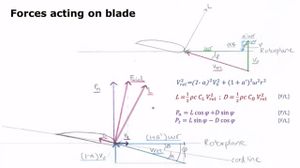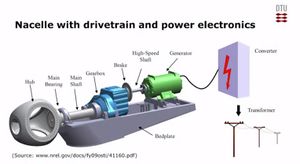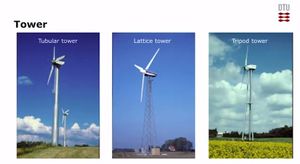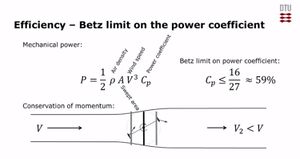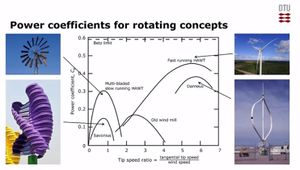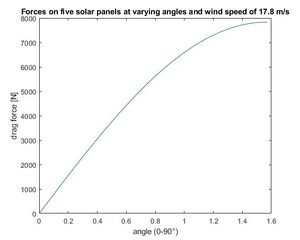Notes - Wind Turbine ISR-G
These are notes for my wind turbine independent study with Jeff Dusek.
Contents
10/07/2020
Wind Speed Measuring
We are using a Vortex wind sensor. One revolution per second equals 2.5 mph. Since our anemometer has a relay (a mechanical switch), it creates a switch bounce. Therefore, we need a debounce circuit.
10/01/2020
Forces on the blade
Moving forward, I will:
- I will look into saving data on SD-card with an Arduino. I will also try to set up Arduino MATLAB.
- order tech components (sd card reader, sd card, voltmeter...)
- Mount new anemometers, and figure out how to read their outputs.
- CAD solar panel mount. (I just couldn't find the time to do that last week.)
- clear out the area for solar panel mounts and start locating post holes
- Reassess locations for turbines. I have been trying to find spots, but I will approach this question more professionally.
- find fluid dynamics book?
- take more quizzes
9/24/2020
Wind Turbine Terminology
- rotor - generates aerodynamic torque
- nacelle - converts torque into electrical power
- tower - hold nacelle and rotor blades
- foundation - hold the whole turbine in place
Main degrees of conventional Darrieus turbine
- azimuth - rotation of rotor to generator
- yaw - rotation of nacelle about vertical tower
- pitch - angle/pitch of blades about their lengthwise axis
Towers
- tubular towers
- lattice towers
- tripod towers
Foundation
Foundations are oftentimes made out of concrete.
Wind Energy Extraction
The mechanical power of a turbine can be calculated with the equation to the right. The Betz limit on the power of a fast-spinning wind turbine (59%) describes the maximum energy that a turbine can extract from the wind.
Rotating lift-based machines
Horizontal axis wind turbine, Darrieus turbine, vertical axis wind turbine with blades,
Rotating drag-based machines
Vertical axis turbines - similar to cup anemometer; Savonius (efficiency 10%-15%) could be nice for aesthetically pleasing turbine
Flying lift-based machines
pulls up sail that pulls on a cord that spins spindel
Machines using flow-induced vibrations
Financing
Our revenue is the production of net electricity in Wh (Annual Energy Production): Capacity of Farm x 8760h x capacity factor 0.25
1 - Simple payback time (SPT)
Simplistic Calculation
- estimate of annual production in Wh
- annual revenue - production x energy sale price
- annual operating costs
2 - Net present value (NPV)
(revenue - costs) - original investment
if less than 0, probably not profitable
excel has NPV function
3 - Levelised cost of Energy (LCoE)
goal is to find cost per MWh that can be used for comparison:
(Capital Investment + Operational Costs + Decommissioning Cost)/ MWh
Wind Drag on Solar Panel Plate
Individual solar panels have an aspect ratio of 1:2 (62.2 x 31.8 x 1.4 inches). The current plan for the five panels is to mount them side by side resulting in an aspect ratio of 1:2.56 (62.2 x 159 x 1.4 inches).
F = 1/2 * p * v^2 * A * 2pi * sin(alpha); (p - density of air, v - wind speed, 2pi sin(a) - drag coefficient); density of 10 celsius air - 1.246 kg/m^3;
solar panel dimension - 62.2 x 31.8 x 1.4 inches - 1.58m x 0.8m x 0.0355; area = 1.264 m^2
Lift on all five panels: F = 0.5 * 1.246 kg/m^3 * (17.8 m/s)^2 * 1.264 m^2 * 5 * 2pi * sin(a) <= 7835 N
Sources
- Maximum Wind Speeds in the Southern States
- Paper on wind lift on photovoltaic panels - Researchgate
- The Flat Plate Airfoil
Remote Wind Speed Sensing
- two challanges: low noise to signal ratio, need to measure volume not single point
- LIDAR & SODAR Doppler shift measuring; LIDAR measurements are more precise
Statistical Analysis of Wind Speeds and Turbulence
- Navier-Stokes equation (evolution equation) to calculate wind speeds in space
- statistical analysis, spectra, turbulence intensity is obtained by mean wind speed and standard deviation of wind speeds
- every wavelength (after Fourier transform) can be thought of as a length scale
- wind vector (u, v, w)
- integral length scale; from time series, we compute the auto-correlation function
- turbulence spectra
- averaging periods of 10 min are commonly used; 30 min period for turbulence studies; the larger integral time scale, the larger should be averaging period; sampling frequencies should be much smaller than integral time scale
- you have to detrend te time series to get rid of high-frequency fluctuation
Sources:
Flat Plate Approximation - Caltech
Transition to turbulence begins when some flow instability (such as the instability analyzed in sections (Bkc) and (Bkd)) leads to some fairly large scale disturbance(s) or “eddies” in the flow field. As these disturbances gather energy from the mean flow, they begin to spawn smaller disturbances or eddies which, in turn spawn even smaller eddies. This process ends because, eventually, the eddies reach a size for which viscous effects become important and the very small eddies are damped out by viscosity. Eventually, the spectrum of spatial or temporal eddy sizes reaches a “fully developed” state in which energy is fed from the mean flow into large eddies and then continually cascades down to smaller and then smaller eddies eventually reaching a size at which viscosity becomes important and damps out those small eddies. In this fully-developed state the disturbance energy for any one size of eddy becomes relatively constant though it can, of course, continue to change with the flow conditions.
Next Steps
- write up questions about auto-correlation function
- include lift coefficient in flat plate lift equation
- reading on the efficiency of vertical turbines vs conventional turbines
- interview farmer Ann again
- ask Ayden to mount anemometer
- CAD solar panel construction, include Jasmine
9/17/2020 - Wind Profiles
What I did:
- I measured wind speeds throughout the week. At a height of 4 m, the wind speeds vary around 0-4 mph. We had gust of up to 10-15 mph. However, wind speeds seem to be quite low. From talking to a nearby farmer I learned that wind speeds increase during the months November - January.
- I completed the first two weeks on Coursera, but I didn't take the quizzes due to limited time
- We have been working on a mount for the five solar panels. We will most likely build a solar-sail that rotates around its middle axis. Its angle of rotation can be manually adjusted for winter and summer times. We will have to dig at least four post holes to keep the construction sturdy during heavy storms.
- the surface roughness is important for wind energy estimations
- surface roughness is hard to determine
To Do:
- orientation of the turbine
- mount anemometer higher up in the trees
- look into turbine tree mounting techniques
- finish week three and take week 2 quizzes
- work when it doesn't rain
- what's the surface roughness here at the farm?
- find possible turbine spots
- research boundary layers and atmospheric stability correction
- look into calculating the lift of solar panels (flat plate approximation - coefficient for lift and drag)
9/12/2020 - I began Coursera Course
- we have a hight surface roughness probably around z_0=0.4 (wind profiles)
- Eddies are swirls of a fluid and it's reverse current in a turbulent flow regime (Wikipedia)
Wind Resource Assessment
- due to roughness of the forest, wind speed increases
- The Wind Atlas Analysis And Application Program (WAsP) provides an upward and downard analysis of the terrain
- on top of hills, we have over speeding due to continuity
- What is Weibull distribution?
9/10/2020 - First Semester Call with Jeff
site assessment - take photography and topography
data collection with raspi anemometer
hard part: is there enough detail in the Coursera course?
deliverables: structural design of design the tower, beam bending, blade design --> lifting line theory
model for the amount of power --> modeling in Simulink --> amount of wind, size of turbine...
Grade? --> a few deliverables: weekly journal entry/blog, Coursera quizzes (weekly entry), site assessment, modeling,
Get started: Coursera, as you work trough (document built-in quizzes) Do Simulink onramp
To-do for next week:
- Write up ISR-G application
- First week or two of Coursera course, wind resources, tests, and measurement part
- Personal notes in a google doc, final Report - technical report in latex, final deliverable that is more public-facing
